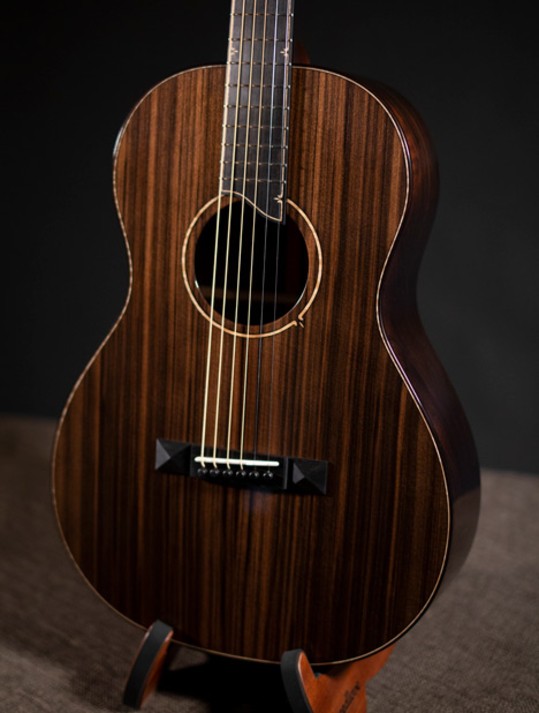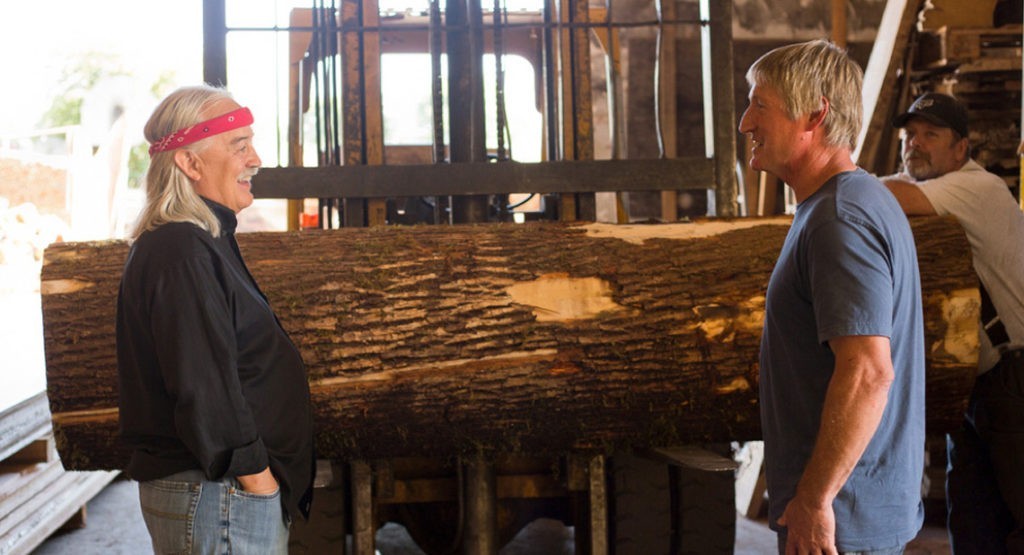Ocean Sinker Redwood

Just west of Portland, Oregon, there’s a sleepy, beach city called Manzanita—the perfect place for a stroll with a friend along sandy, driftwood covered beaches. This is exactly what two area locals were doing one day roughly five years ago, when they discovered a large chunk of jet-black, glimmering wood washed up on the sand.
Eying it for firewood, the locals hauled it home to be cut up, only to find it didn’t burn well. Remarkably, these locals happened to know Bedell’s go-to guy for salvaged tonewoods, Cyril Jacobs, and took their “firewood” to his shop in Tillamook for a second opinion.
“They were thinking that [this was] old-growth fir and they had some great firewood,” said Jacob. “[It was] really fine grain, high silica, you know, saturated material. And they’re saying, ‘yeah, what is this wood? It won’t burn worth a hoot. It’s soaking wet. And we thought it was fir.’ It took me a few seconds to figure out that it was redwood.”
Recreating a tree’s history takes tremendous knowledge of the regional forests and a degree of detective work, but Jacob could see this wasn’t just any redwood. While a measure of imagination and speculation is needed to put together the pieces of a tree’s history and travels through the natural world, the wood was determined to be ancient ocean sinker redwood—likely at least a thousand years old and exceptionally mineral-rich from having been buried first in a river or lakebed at some point in its life then spending an unknown amount of time in the Pacific Ocean. Slow growth contributed to the exceedingly tight-grains while the almost black color, with some lighter marbling and a dramatic shimmer, is attributed to the silica content absorbed while the tonewood rested on the bottom of various bodies of water.
“It shimmers in the sun like it has a glitter rubbed into its surface. In its natural form it is just insane. I’ve had guys who have bought it for high-end custom knives and all sorts of things because of the color, the grain, and that silica,” said Jacob.
Plus, Redwoods don’t grow in Manzanita, Oregon. The only place coastal redwoods grow naturally is California, and a few parts of Southern Oregon, which mean this particular redwood would have traveled north by ocean to find it’s final resting spot—and who knows how long that journey took?
“We don’t know it’s journey for sure, it’s this mystery piece of wood,” said Christensen. “What we do know is that it was a mineral-saturated redwood tree that had to have made it out to the ocean somehow.”
This eons-old wood—which was almost entirely chopped up for firewood—has been on quite the ride. With such a one-of-a-kind look and history, Jacob knew he had to find a way to get some guitar and ukuleles out of this spectacular piece of wood. He took great care in slicing what was left of this unique, dark redwood into tone wood sets, which he promptly showed to Christensen.
She still remembers the sound of her jaw hitting the floor when she first looked at it. Along with its magical color and sheen, Christensen also noticed the characteristics were a little different than typical sinker—it’s mineral-richness had upped its strength and weight, giving it an added element of playability for a top.
“You can dig in a little bit more. You still have this beautiful, highly responsive top to a light finger style touch, it is very responsive that way, but it also has room to play heavier and keep the clarity of each note,” said Christensen.
Jacob, who’s spent the better part of his life salvaging old growth red cedar and redwood, isn’t sure if he’ll ever see another piece like this in his lifetime.
“I’ve [seen] wood that was buried for not centuries, but eons in the ground – there’s stuff that we’d cut once in a while that had been down for two or three thousand years, that’s how it would look in cedar—jet black in color. The hard part at that point is finding something that is that old and still is found, because the fibers start wearing out, and it’s prone to fractures, it gets super brittle,” he said.
Not this sinker—it’s one of the finest cuts of ocean sinker redwood in existence with all the durability, character, and mystery required for a truly breathtaking, distinctive instrument.
The team at Breedlove / Bedell has honored this historic tonewood with an ultra-selective approach to it’s use. It’s been used in a few custom Breedlove guitars and special issue Bedell guitars. Owner Tom Bedell explains, “when you use super rare tonewoods – especially something like the ocean sinker redwood, with looks that rival the attractiveness of the history and story – we owe the tree a high degree of care and respect deciding which guitars are crafted with such a limited resource. When you play an instrument crafted with woods this rare, you’re playing history. The notes you play are voiced from life in an ancient forest, perhaps tumbling down a raging river, and finished by the crashing waves of the Pacific Ocean. You are strumming history.”


